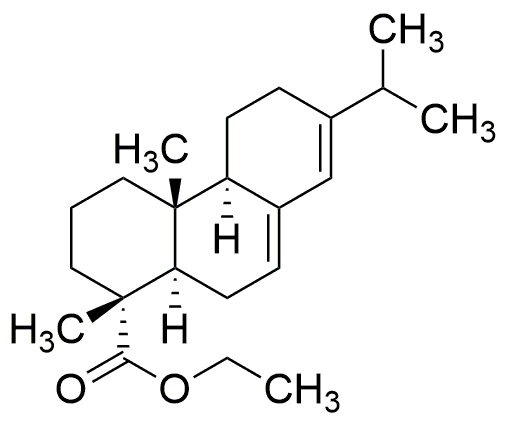Ethyl abietate is widely utilized in research focused on:
- Fragrance Industry: This compound is often used in the formulation of perfumes and fragrances due to its pleasant scent profile, enhancing the aromatic quality of various products.
- Flavoring Agents: Ethyl abietate serves as a flavoring agent in food products, providing a unique taste that can enhance the overall sensory experience for consumers.
- Cosmetic Applications: It is incorporated into cosmetic formulations, acting as a skin-conditioning agent that improves texture and provides a moisturizing effect.
- Pharmaceuticals: The compound is explored for its potential use in drug formulations, where it may act as a solvent or carrier for active pharmaceutical ingredients, improving their bioavailability.
- Research and Development: Ethyl abietate is used in various chemical synthesis processes, allowing researchers to create new compounds with desirable properties for industrial applications.
General Information
Properties
Safety and Regulations
Applications
Ethyl abietate is widely utilized in research focused on:
- Fragrance Industry: This compound is often used in the formulation of perfumes and fragrances due to its pleasant scent profile, enhancing the aromatic quality of various products.
- Flavoring Agents: Ethyl abietate serves as a flavoring agent in food products, providing a unique taste that can enhance the overall sensory experience for consumers.
- Cosmetic Applications: It is incorporated into cosmetic formulations, acting as a skin-conditioning agent that improves texture and provides a moisturizing effect.
- Pharmaceuticals: The compound is explored for its potential use in drug formulations, where it may act as a solvent or carrier for active pharmaceutical ingredients, improving their bioavailability.
- Research and Development: Ethyl abietate is used in various chemical synthesis processes, allowing researchers to create new compounds with desirable properties for industrial applications.
Documents
Safety Data Sheets (SDS)
The SDS provides comprehensive safety information on handling, storage, and disposal of the product.
Product Specification (PS)
The PS provides a comprehensive breakdown of the product’s properties, including chemical composition, physical state, purity, and storage requirements. It also details acceptable quality ranges and the product's intended applications.
Certificates of Analysis (COA)
Search for Certificates of Analysis (COA) by entering the products Lot Number. Lot and Batch Numbers can be found on a product’s label following the words ‘Lot’ or ‘Batch’.
*Catalog Number
*Lot Number
Certificates Of Origin (COO)
This COO confirms the country where the product was manufactured, and also details the materials and components used in it and whether it is derived from natural, synthetic, or other specific sources. This certificate may be required for customs, trade, and regulatory compliance.
*Catalog Number
*Lot Number
Safety Data Sheets (SDS)
The SDS provides comprehensive safety information on handling, storage, and disposal of the product.
DownloadProduct Specification (PS)
The PS provides a comprehensive breakdown of the product’s properties, including chemical composition, physical state, purity, and storage requirements. It also details acceptable quality ranges and the product's intended applications.
DownloadCertificates of Analysis (COA)
Search for Certificates of Analysis (COA) by entering the products Lot Number. Lot and Batch Numbers can be found on a product’s label following the words ‘Lot’ or ‘Batch’.
*Catalog Number
*Lot Number
Certificates Of Origin (COO)
This COO confirms the country where the product was manufactured, and also details the materials and components used in it and whether it is derived from natural, synthetic, or other specific sources. This certificate may be required for customs, trade, and regulatory compliance.


